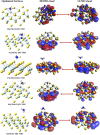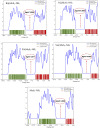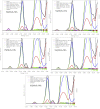Heteroatoms (Si, B, N, and P) doped 2D monolayer MoS2 for NH3 gas detection
- PMID: 36199611
- PMCID: PMC9468912
- DOI: 10.1039/d2ra04028j
Heteroatoms (Si, B, N, and P) doped 2D monolayer MoS2 for NH3 gas detection
Retraction in
-
Retraction: Heteroatoms (Si, B, N, and P) doped 2D monolayer MoS2 for NH3 gas detection.RSC Adv. 2025 Apr 4;15(14):10533. doi: 10.1039/d5ra90040a. eCollection 2025 Apr 4. RSC Adv. 2025. PMID: 40190647 Free PMC article.
Abstract
2D transition metal dichalcogenide MoS2 monolayer quantum dots (MoS2-QD) and their doped boron (B@MoS2-QD), nitrogen (N@MoS2-QD), phosphorus (P@MoS2-QD), and silicon (Si@MoS2-QD) surfaces have been theoretically investigated using density functional theory (DFT) computation to understand their mechanistic sensing ability, such as conductivity, selectivity, and sensitivity toward NH3 gas. The results from electronic properties showed that P@MoS2-QD had the lowest energy gap, which indicated an increase in electrical conductivity and better adsorption behavior. By carrying out comparative adsorption studies using m062-X, ωB97XD, B3LYP, and PBE0 methods at the 6-311G++(d,p) level of theory, the most negative values were observed from ωB97XD for the P@MoS2-QD surface, signifying the preferred chemisorption surface for NH3 detection. The mechanistic studies provided in this study also indicate that the P@MoS2-QD dopant is a promising sensing material for monitoring ammonia gas in the real world. We hope this research work will provide informative knowledge for experimental researchers to realize the potential of MoS2 dopants, specifically the P@MoS2-QD surface, as a promising candidate for sensors to detect gas.
This journal is © The Royal Society of Chemistry.
Conflict of interest statement
All authors declare zero financial or inter-personal conflict of interest that could have influenced the research work or results reported in this research paper.
Figures






Similar articles
-
Molecular simulation of Cu, Ag, and Au-decorated Si-doped graphene quantum dots (Si@QD) nanostructured as sensors for SO2 trapping.J Mol Graph Model. 2023 Nov;124:108551. doi: 10.1016/j.jmgm.2023.108551. Epub 2023 Jun 29. J Mol Graph Model. 2023. PMID: 37399776
-
Density Functional Theory Study of B, N, and Si Doped Penta-Graphene as the Potential Gas Sensors for NH3 Detection.Membranes (Basel). 2022 Jan 8;12(1):77. doi: 10.3390/membranes12010077. Membranes (Basel). 2022. PMID: 35054603 Free PMC article.
-
Electronic and Magnetic Properties of Encapsulated MoS2 Quantum Dots: The Case of Noble Metal Nanoparticle Dopants.Chemphyschem. 2016 Apr 18;17(8):1180-94. doi: 10.1002/cphc.201501131. Epub 2016 Feb 19. Chemphyschem. 2016. PMID: 26817440
-
Highly Sensitive Gas Sensor for Detection of Air Decomposition Pollutant (CO, NOx): Popular Metal Oxide (ZnO, TiO2)-Doped MoS2 Surface.ACS Appl Mater Interfaces. 2024 Jan 24;16(3):3674-3684. doi: 10.1021/acsami.3c15103. Epub 2024 Jan 10. ACS Appl Mater Interfaces. 2024. PMID: 38198663
-
Heteroatom-Doped Molybdenum Disulfide Nanomaterials for Gas Sensors, Alkali Metal-Ion Batteries and Supercapacitors.Nanomaterials (Basel). 2023 Jul 26;13(15):2182. doi: 10.3390/nano13152182. Nanomaterials (Basel). 2023. PMID: 37570500 Free PMC article. Review.
Cited by
-
Single-atoms (N, P, S) encapsulation of Ni-doped graphene/PEDOT hybrid materials as sensors for H2S gas applications: intuition from computational study.Sci Rep. 2023 Nov 1;13(1):18856. doi: 10.1038/s41598-023-46153-5. Sci Rep. 2023. Retraction in: Sci Rep. 2024 Aug 21;14(1):19379. doi: 10.1038/s41598-024-70290-0. PMID: 37914823 Free PMC article. Retracted.
-
First-principle study of Cu-, Ag-, and Au-decorated Si-doped carbon quantum dots (Si@CQD) for CO2 gas sensing efficacies.J Mol Model. 2023 Jul 5;29(8):229. doi: 10.1007/s00894-023-05627-z. J Mol Model. 2023. PMID: 37407799
-
Impact of Polythiophene ((C4H4S)n; n = 3, 5, 7, 9) Units on the Adsorption, Reactivity, and Photodegradation Mechanism of Tetracycline by Ti-Doped Graphene/Boron Nitride (Ti@GP_BN) Nanocomposite Materials: Insights from Computational Study.ACS Omega. 2023 Oct 30;8(45):42340-42355. doi: 10.1021/acsomega.3c04625. eCollection 2023 Nov 14. ACS Omega. 2023. PMID: 38024685 Free PMC article.
-
Synthesis, characterization, and molecular modeling of phenylenediamine-phenylhydrazine-formaldehyde terpolymer (PPHF) as potent anti-inflammatory agent.Heliyon. 2023 Jul 6;9(7):e18067. doi: 10.1016/j.heliyon.2023.e18067. eCollection 2023 Jul. Heliyon. 2023. PMID: 37483726 Free PMC article.
-
Exploring the potential of single-metals (Cu, Ni, Zn) decorated Al12N12 nanostructures as sensors for flutamide anticancer drug.Heliyon. 2023 Oct 11;9(10):e20682. doi: 10.1016/j.heliyon.2023.e20682. eCollection 2023 Oct. Heliyon. 2023. PMID: 37867907 Free PMC article.
References
-
- Kumar V. P. Panda D. K. Next Generation 2D Material Molybdenum Disulfide (MoS2): Properties, Applications and Challenges. ECS J. Solid State Sci. Technol. 2022;11(3):033012.
-
- Brown C. M. B., Nepomuceno R. A., Anarna J. A. and Brown M. B., New and Future Developments in Microbial Biotechnology and Bioengineering, Plant growth promoting rhizobacteria-Advances and future prospects, 2022, pp. 1–28
-
- Fang W. T., Envisioning Environmental Literacy, Springer, Singapore, 2020
Publication types
LinkOut - more resources
Full Text Sources
Miscellaneous

